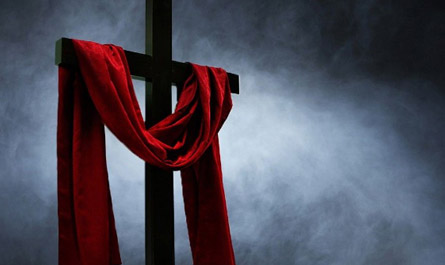By Alice Huth-Derrah
Steeped in the richness of tradition and symbolism, the observance of Good Friday services has taken place since the earliest days of the Catholic Church. It has never been an easy day for Christians, nor should it be, just as it wasn’t for those who were there on that terrible, fateful day. We gather in silence and leave in silence, mournfully. The church, the readings, the music, and the atmosphere are solemn. The impact of this day is meant to be experienced as heart-wrenching because we are called to come as close as we can to imagining that which is unimaginable – the tortuous crucifixion of the Son of God. Yet because we are living now, we have the good fortune of knowing what is to come and that it isn’t an ending; it’s the beginning.
Good Friday services, the second day of the Easter Triduum, began at 3:00 p.m. at St. Elizabeth Seton, a popular time for the services to be held since it represents the hours of blackness that covered the land until Jesus’ death. No usual mass is celebrated on this day. All aspects of the services are meant to be reminders of the suffering Jesus endured after His betrayal, arrest, trial, and torture, all culminating in His death on the cross. The church itself feels stark and unwelcoming, without ornamentation; the altar is bare and the door of the tabernacle is open to reveal its awful emptiness. It will be a dark world without Christ.
The services commence with the cross, covered in cloth, being carried into the church. The congregation listens to the account of the Lord’s Passion, taken from the Gospel of John, and the story of that day’s horrible events unfold. We join Jesus and His disciples, the Jews and the
Romans, and with the startling words shouted out, “Crucify him! Crucify him!” we feel plunged into the hopelessness Christ’s first followers must have experienced. Intercessory prayers are offered for the Church, community, and the world. All attendees are invited to participate in the Veneration or Adoration of the Cross, a beautiful and profoundly moving way of honoring the great sacrifice Jesus made for us. The faithful bow down or kneel before the Cross, while some place their hand on the Cross or kiss it. This is the symbol we recognize as our path to salvation given to us by Christ. Since we receive Communion on Good Friday, the service is also called the Mass of the Presanctified because the Hosts used have already been consecrated. Then, the service over, the parishioners depart as they arrived: silently, mournfully.
I have often heard people say that no matter how often they read the part of the gospel describing how brutally Jesus was treated and died, they always wish it could have played out differently, and I feel the same way. This day gives us the opportunity to contemplate our death to sin and the priceless treasure of salvation purchased for us at the highest cost when Jesus willingly gave up his life. The last words Jesus utters before He dies are “It is finished.” (John 19:30). Jesus isn’t saying there is no more, but rather that He has completed what He needed to do to save us, to save the world. Even though we symbolically join those present on the day of Christ’s crucifixion to hear those words, to “bear witness” to the death of the Savior, we possess the knowledge of historical context. Christ will rise from the dead! Though somber, Good Friday services are also marked by something more – the joyous, rapturous conviction in knowing we are blessed with the greatest outcome possible…redemption!

